Salton Sea &
Imperial Valley
4 Sep
2006
by
Henry Detwiler
Mickey and I braved the 109-degree heat & humidity to hunt down some
fine Imperial Valley birds.
94
species--bird list is at the bottom of the page
Click on
thumbnail pictures for full-sized photos. 
|
We left Yuma at 5:30am and started our birding in the Imperial
Valley just as the sun peeked over the horizon. A flooded
field of Bermuda Grass highlighted why so many birders make the
pilmigrage to the Salton Sea area. It was teeming with 100's
of White-faced Ibis, egrets, Willets, Black-necked Stilts,
yellowlegs, dowitchers, Wilson's Phalaropes, and other birds.
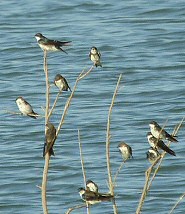
Tree & Bank Swallows at
Finney
|
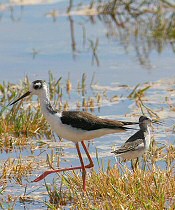
Black-necked Stilt
& Wilson's Phalarope
At Finney Lake we found both Western and Clark's Grebes, and found almost
all the small dead snags emerging from the water covered with swallows--mostly Tree, but a
sprinkling of
Bank and Cliff Swallows, too. |
|
Our first stop at the Salton Sea itself was Obsidian Butte. The east side
of this peninsula was as birdy as I've ever seen it, with terns, pelicans, gulls, and cormorants.
|
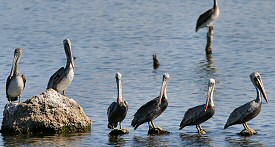
Brown Pelicans at Obsidian
Butte
|
|
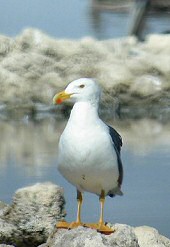
Yellow-footed Gull |
Here we found Mickey's life Yellow-footed Gull--lots of them, in
fact. The Yellow-footed Gulls rear their young in the Gulf of
California, and then fly up to the Salton Sea for a post-breeding
vacation. During the late summer you can find hundreds
here--but come the winter there are only a few left on the entire
sea. While the east side of Obsidian Butte was great,
the west side was fantastic! Hundreds each of Caspian Terns,
Black Skimmers, and Brown Pelicans shared the islands and
surrounding waters with other terns, gulls, and shorebirds. |
|
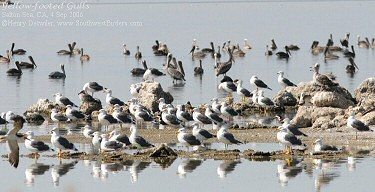
Yellow-footed Gulls & Brown Pelicans |
|
|
When startled, the Black Skimmers and Caspian Terns would lift off
the islands and wheel around a couple of times before landing
again, rearranging
themselves in the viewing arena. |
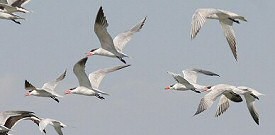
Caspian Terns |
|
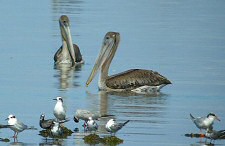
Black, Forster's, & Common Terns
and Brown Pelicans, of course! |
This turned out to be an excellent spot to examine an assortment of terns
in a variety of plumages: Black, Forster's, and Common.
Offshore from here there had been several sightings of jaegers earlier in the day--but we
missed them.
|
|
Following the sea wall to the south, we came upon this falcon
surveying the shoreline for lunch. It stayed put long enough for
me to take this digiscoped shot with my Sony DSC W7, hand-held up
to the eyepiece of my
Swarovski 65mm spotting scope. A nearby field held several
hundred Laughing and Bonaparte's Gulls.
|
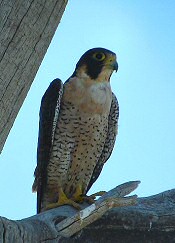
Peregrine Falcon
|
|

Black Tern
|
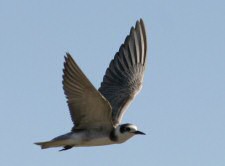
Black Tern
|
|
The irrigated fields in the Imperial Valley are not all alike by any
means. Many have their own unique species, depending on the
height of the water, type of crop, and available food sources.
A couple of fields seemed to attract good numbers of Black Terns,
while others had none. Similarly, we found a flock of
Black-bellied Plovers in one field, and saw them nowhere else.
|
|

Ruff, Imperial Valley |
In a field close to Hoober Road & Hwy 115, we met Guy McCaskie and Gjon
Hazard. They pointed out some Baird's Sandpipers, and then
we moved together to another flock of shorebirds in a different
part of the field. Here I found this colorful Ruff, which
was our rarest bird of the day. After looking over a few
more watery fields, Mickey and I called it quits--driven out by the heat and
humidity. But it had been an amazing day, filled with the
spectacle of 1000s of beautiful birds! |
|